Start engine JAGUAR XF 2009 1.G Owner's Manual
[x] Cancel search | Manufacturer: JAGUAR, Model Year: 2009, Model line: XF, Model: JAGUAR XF 2009 1.GPages: 391, PDF Size: 19.32 MB
Page 134 of 391
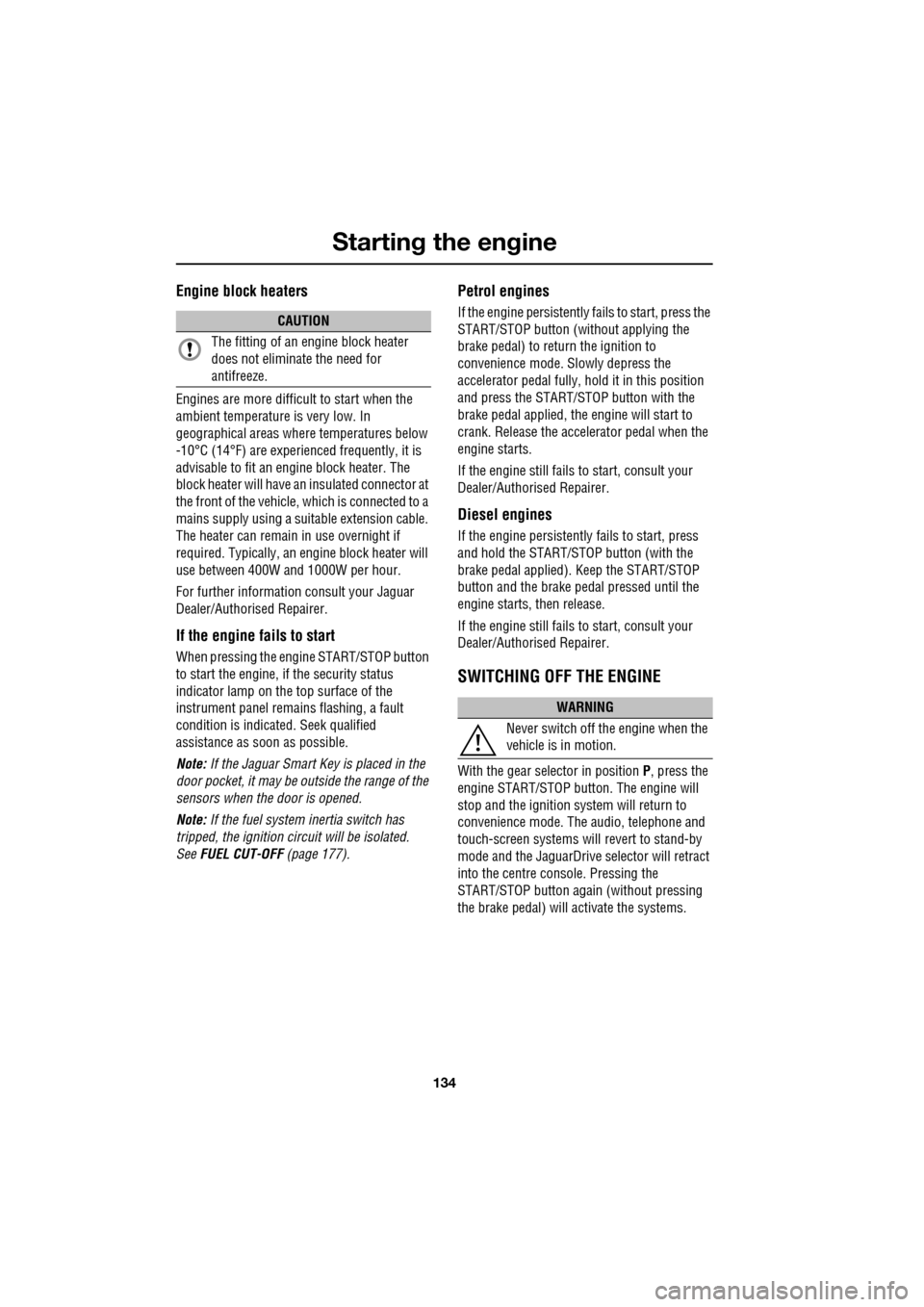
Starting the engine
134
Engine block heaters
Engines are more difficult to start when the
ambient temperature is very low. In
geographical areas where temperatures below
-10°C (14°F) are experienced frequently, it is
advisable to fit an engine block heater. The
block heater will have an insulated connector at
the front of the vehicle, which is connected to a
mains supply using a suitable extension cable.
The heater can remain in use overnight if
required. Typically, an e ngine block heater will
use between 400W and 1000W per hour.
For further information consult your Jaguar
Dealer/Authorised Repairer.
If the engine fails to start
When pressing the engine START/STOP button
to start the engine, if the security status
indicator lamp on the top surface of the
instrument panel rema ins flashing, a fault
condition is indicate d. Seek qualified
assistance as soon as possible.
Note: If the Jaguar Smart Key is placed in the
door pocket, it may be outside the range of the
sensors when the door is opened.
Note: If the fuel system inertia switch has
tripped, the ignition circuit will be isolated.
See FUEL CUT-OFF (page 177).
Petrol engines
If the engine persistently fails to start, press the
START/STOP button (without applying the
brake pedal) to return the ignition to
convenience mode. Slowly depress the
accelerator pedal fully, hold it in this position
and press the START/STOP button with the
brake pedal applied, the engine will start to
crank. Release the accelerator pedal when the
engine starts.
If the engine still fails to start, consult your
Dealer/Authorised Repairer.
Diesel engines
If the engine persistently fails to start, press
and hold the START/STOP button (with the
brake pedal applied). Keep the START/STOP
button and the brake pedal pressed until the
engine starts, then release.
If the engine still fails to start, consult your
Dealer/Authorised Repairer.
SWITCHING OFF THE ENGINE
With the gear selector in position P, press the
engine START/STOP button. The engine will
stop and the ignition syst em will return to
convenience mode. The audio, telephone and
touch-screen systems will revert to stand-by
mode and the JaguarDrive selector will retract
into the centre console. Pressing the
START/STOP button ag ain (without pressing
the brake pedal) will activate the systems.
CAUTION
The fitting of an engine block heater
does not eliminate the need for
antifreeze.
WARNING
Never switch off the engine when the
vehicle is in motion.
Page 135 of 391
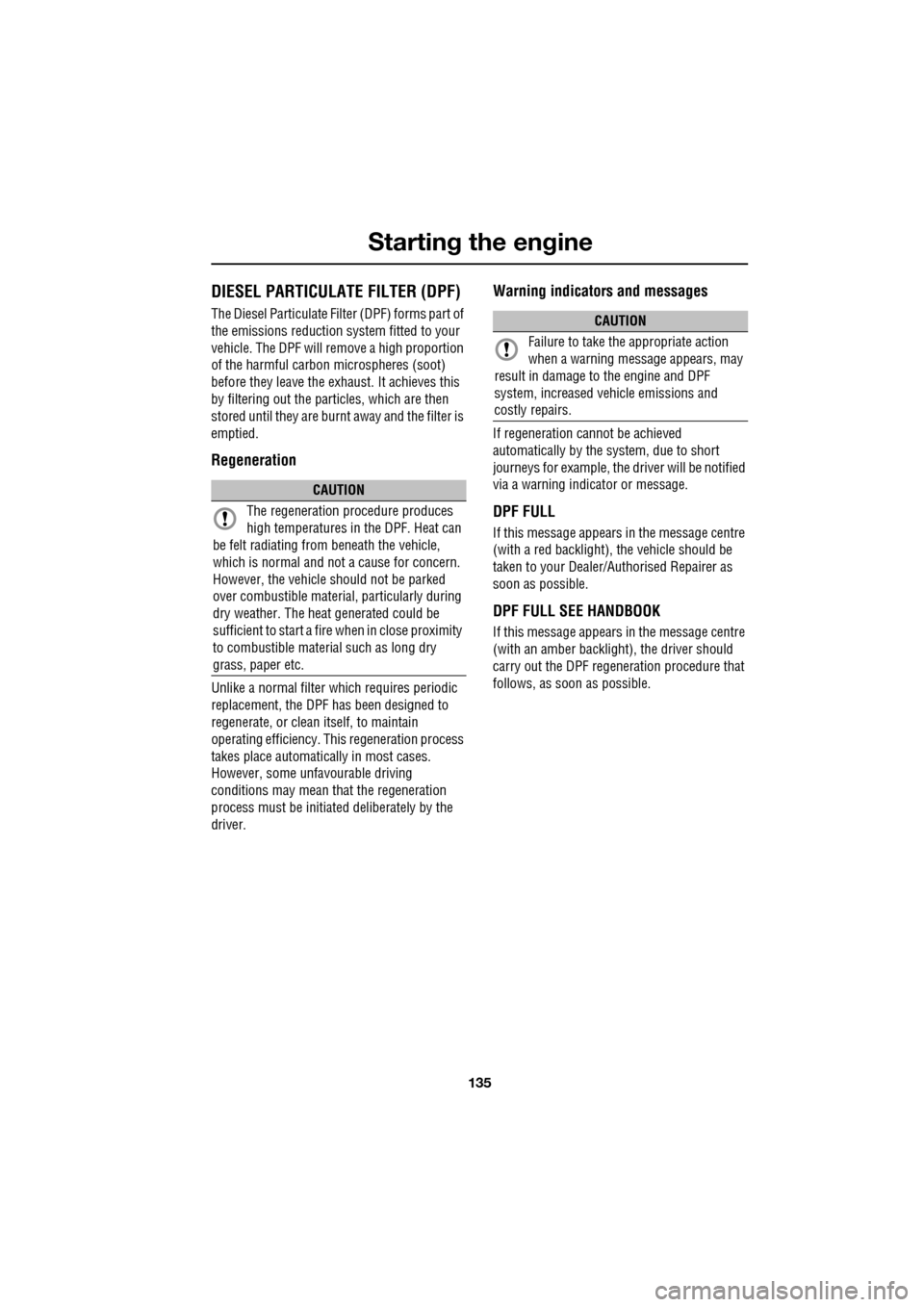
135
Starting the engine
DIESEL PARTICULATE FILTER (DPF)
The Diesel Particulate Filter (DPF) forms part of
the emissions reduction system fitted to your
vehicle. The DPF will remove a high proportion
of the harmful car bon microspheres (soot)
before they leave the exhaust. It achieves this
by filtering out the particles, which are then
stored until they are burnt away and the filter is
emptied.
Regeneration
Unlike a normal filter which requires periodic
replacement, the DPF has been designed to
regenerate, or clean itself, to maintain
operating efficiency. Th is regeneration process
takes place automatically in most cases.
However, some unfavourable driving
conditions may mean th at the regeneration
process must be initiate d deliberately by the
driver.
Warning indicators and messages
If regeneration cannot be achieved
automatically by the system, due to short
journeys for example, the driver will be notified
via a warning indicator or message.
DPF FULL
If this message appears in the message centre
(with a red backlight), the vehicle should be
taken to your Dealer/Authorised Repairer as
soon as possible.
DPF FULL SEE HANDBOOK
If this message appears in the message centre
(with an amber backlight), the driver should
carry out the DPF regene ration procedure that
follows, as soon as possible.
CAUTION
The regeneration procedure produces
high temperatures in the DPF. Heat can
be felt radiating from beneath the vehicle,
which is normal and not a cause for concern.
However, the vehicle should not be parked
over combustible material, particularly during
dry weather. The heat generated could be
sufficient to start a fire when in close proximity
to combustible material such as long dry
grass, paper etc.
CAUTION
Failure to take the appropriate action
when a warning message appears, may
result in damage to the engine and DPF
system, increased vehicle emissions and
costly repairs.
Page 136 of 391
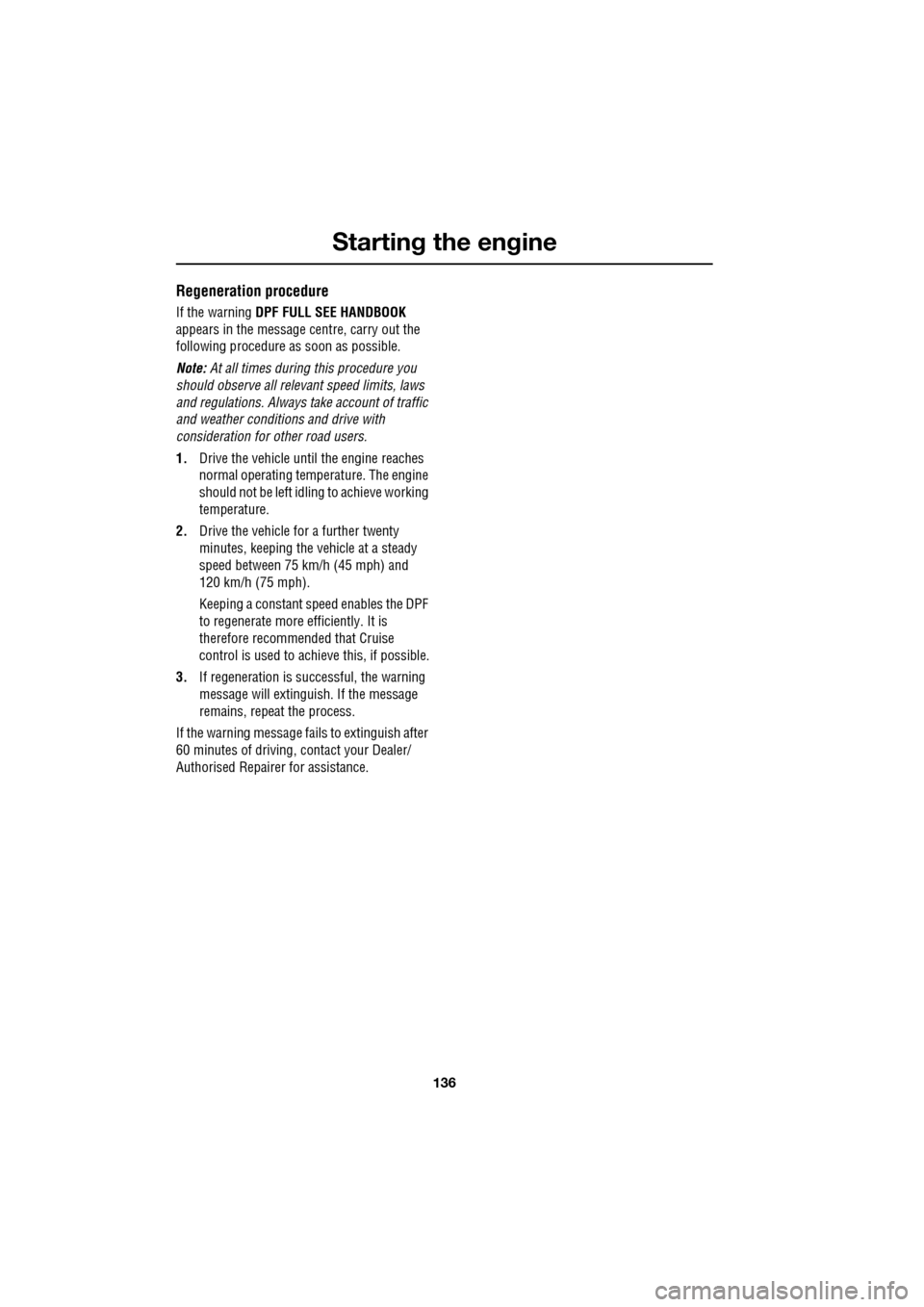
Starting the engine
136
Regeneration procedure
If the warning DPF FULL SEE HANDBOOK
appears in the message centre, carry out the
following procedure as soon as possible.
Note: At all times during this procedure you
should observe all releva nt speed limits, laws
and regulations. Always ta ke account of traffic
and weather conditions and drive with
consideration for other road users.
1. Drive the vehicle until the engine reaches
normal operating temp erature. The engine
should not be left idli ng to achieve working
temperature.
2. Drive the vehicle for a further twenty
minutes, keeping the vehicle at a steady
speed between 75 km/h (45 mph) and
120 km/h (75 mph).
Keeping a constant speed enables the DPF
to regenerate more efficiently. It is
therefore recommended that Cruise
control is used to achieve this, if possible.
3. If regeneration is su ccessful, the warning
message will extinguish. If the message
remains, repeat the process.
If the warning message fa ils to extinguish after
60 minutes of driving, contact your Dealer/
Authorised Repairer for assistance.
Page 137 of 391

137
Transmission
AUTOMATIC TRANSMISSION
The transmission system is designed to
operate in two distinct modes, conventional
automatic and Jaguar Sequential Shift.
The automatic modes are accessed by the gear
selector:
•D - Drive - automatic shifting.
• S - Sport - sport automatic shifting.
The Jaguar Sequential Shift mode enables
sequential manual gear selection in D
(temporary) and S (permanent) modes, via the
steering wheel m ounted paddles.
Note: In addition to the st andard shift patterns
available in D and S, the transmission will
adapt to differing conditions by modifying shift
points, based upon vehicl e sensor information
for road gradient, cornering, braking pressure
and driving style.
JaguarDrive selector
The JaguarDrive selector elevates out of the
centre console when the engine is started, in
readiness for gear selection. Press the brake
pedal, then rotate the control to select the
chosen gear ( P, R , N or D) or, from D, press
down on the control and rotate to select S
(Sport).
CAUTIONS
Never select the Park ( P) position whilst
the vehicle is in motion. Doing so may
cause serious damage to the transmission.
Never select the Reverse ( R) position
whilst the vehicle is in forward motion.
Doing so may cause serious damage to the
transmission.
Never select a forward gear whilst the
vehicle is in rearward motion. Doing so
may cause serious damage to the
transmission.
Do not rev the engine or allow it to run
above normal idle speed while selecting
D or R, or while the vehicle is stationary with
any gear selected.
Do not allow the vehicle to remain
stationary for any length of time, with a
gear selected and the engine running. Always
select P or N if the engine is to idle for a
prolonged period.
E94119
Page 139 of 391
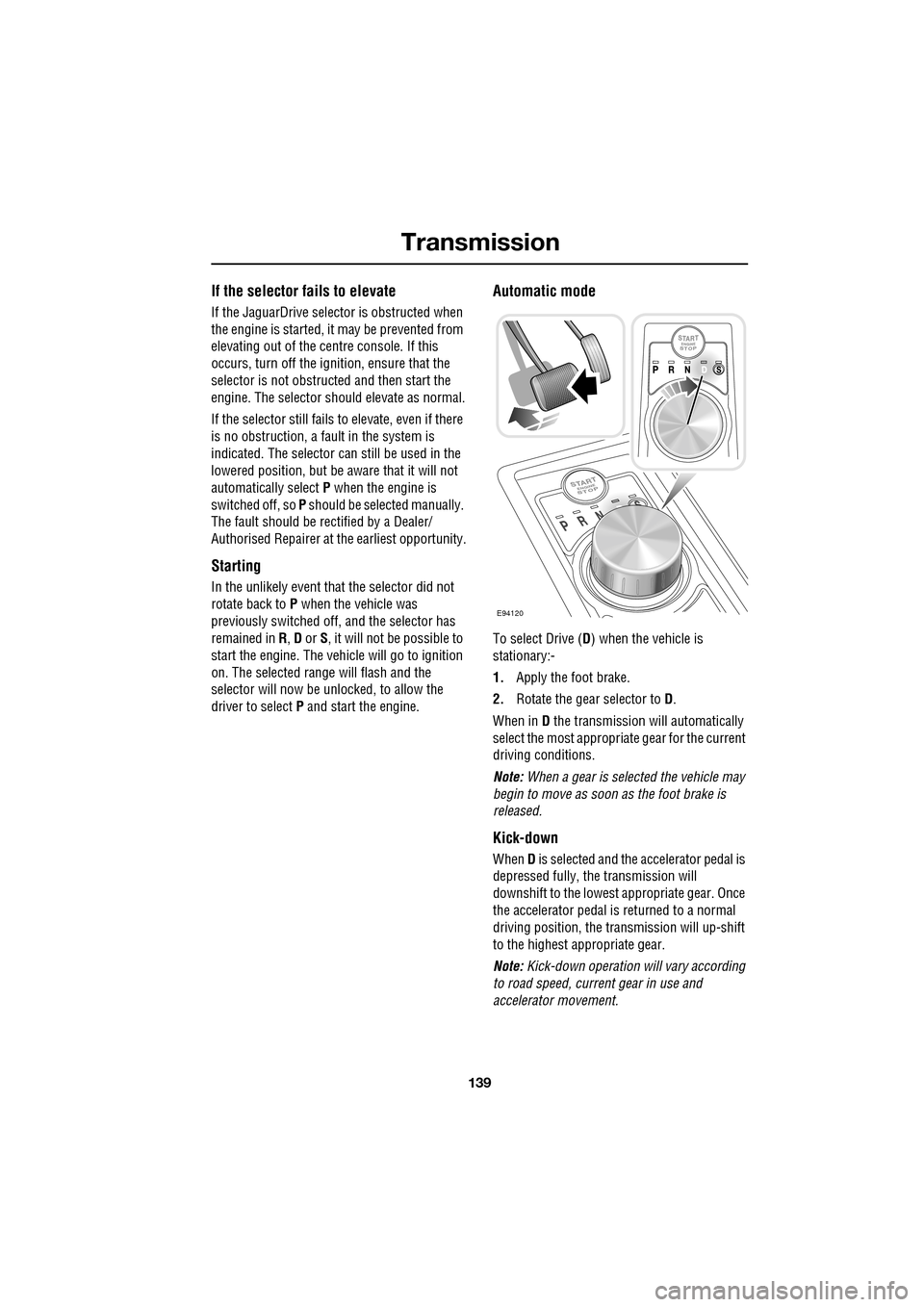
139
Transmission
If the selector fails to elevate
If the JaguarDrive selector is obstructed when
the engine is started, it may be prevented from
elevating out of the centre console. If this
occurs, turn off the ignition, ensure that the
selector is not obstruc ted and then start the
engine. The selector s hould elevate as normal.
If the selector still fails to elevate, even if there
is no obstruction, a faul t in the system is
indicated. The selector ca n still be used in the
lowered position, but be aware that it will not
automatically select P when the engine is
switched off, so P should be sele cted manually.
The fault should be re ctified by a Dealer/
Authorised Repairer at the earliest opportunity.
Starting
In the unlikely event that the selector did not
rotate back to P when the vehicle was
previously switched off, and the selector has
remained in R, D or S, it will not be possible to
start the engine. The vehicle will go to ignition
on. The selected range will flash and the
selector will now be unlocked, to allow the
driver to select P and start the engine.
Automatic mode
To select Drive (D) when the vehicle is
stationary:-
1. Apply the foot brake.
2. Rotate the gear selector to D.
When in D the transmission will automatically
select the most appropriate gear for the current
driving conditions.
Note: When a gear is selected the vehicle may
begin to move as soon as the foot brake is
released.
Kick-down
When D is selected and the accelerator pedal is
depressed fully, the transmission will
downshift to the lowest appropriate gear. Once
the accelerator pedal is returned to a normal
driving position, the tr ansmission will up-shift
to the highest appropriate gear.
Note: Kick-down operation will vary according
to road speed, current gear in use and
accelerator movement.
E94120
Page 155 of 391

155
Driving hints
ECONOMICAL DRIVING
There are two main factors which influence fuel
economy, the way the vehicle is driven and
maintenance.
Driving tips for economy
•Avoid unnecessary jour neys, especially
short stop-start trips.
• Accelerate smoothly and gently from a
stand still.
• Allow time to brake gently and smoothly.
• Be aware of traffic and road conditions
ahead, and take action in time to avoid
hard braking or acceleration.
• When stationary apply the park brake, and
select neutral.
• Turn off the air conditioning when not
needed.
Maintenance and fuel economy
Regular servicing by a Dealer/Authorised
Repairer, along with regular checks by the
driver are essential fo r vehicle longevity and
fuel economy.
The condition of the engine (oils, filters, spark
plugs, settings etc.) tyre pressures, and wheel
alignment, will all have a bearing on fuel
economy. For this reason it is essential that the
vehicle is checked regularly by the driver and
serviced by an approved Dealer/Authorised
Repairer at the correct intervals.
Note: If you are in any doubt about the
maintenance requirement s, intervals, or
checks required, contact your Dealer/
Authorised Repairer for advice.
Page 174 of 391
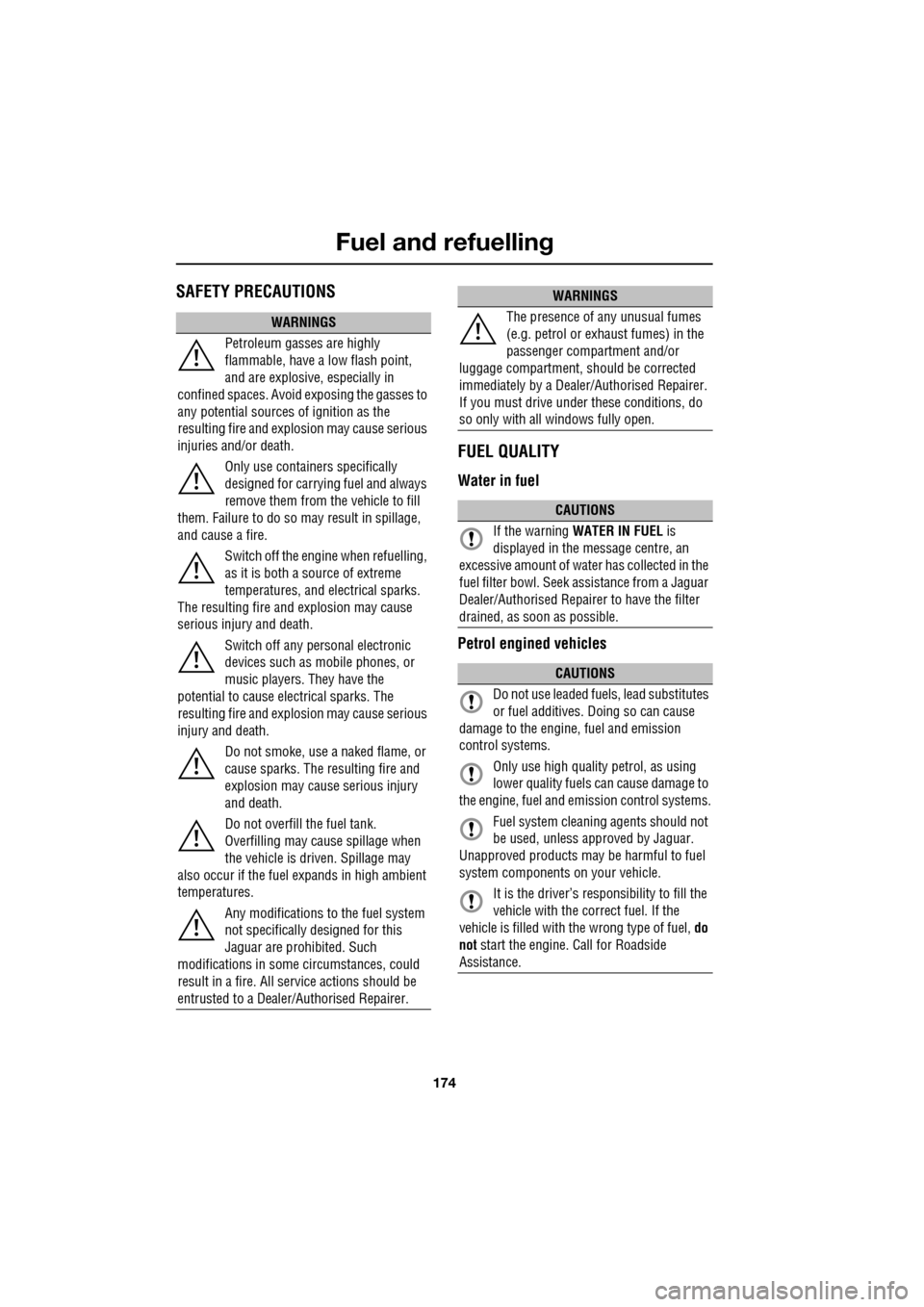
Fuel and refuelling
174
SAFETY PRECAUTIONSFUEL QUALITY
Water in fuel
Petrol engined vehicles
WARNINGS
Petroleum gasses are highly
flammable, have a low flash point,
and are explosive, especially in
confined spaces. Avoid exposing the gasses to
any potential sources of ignition as the
resulting fire and expl osion may cause serious
injuries and/or death.
Only use containe rs specifically
designed for carrying fuel and always
remove them from the vehicle to fill
them. Failure to do so may result in spillage,
and cause a fire.
Switch off the engine when refuelling,
as it is both a source of extreme
temperatures, and electrical sparks.
The resulting fire a nd explosion may cause
serious injury and death.
Switch off any personal electronic
devices such as mobile phones, or
music players. They have the
potential to cause electrical sparks. The
resulting fire and expl osion may cause serious
injury and death.
Do not smoke, use a naked flame, or
cause sparks. The resulting fire and
explosion may cause serious injury
and death.
Do not overfill the fuel tank.
Overfilling may cause spillage when
the vehicle is driven. Spillage may
also occur if the fuel expands in high ambient
temperatures.
Any modifications to the fuel system
not specifically designed for this
Jaguar are prohibited. Such
modifications in some circumstances, could
result in a fire. All se rvice actions should be
entrusted to a Dealer /Authorised Repairer.The presence of any unusual fumes
(e.g. petrol or exhaust fumes) in the
passenger compartment and/or
luggage compartment, should be corrected
immediately by a Dealer /Authorised Repairer.
If you must drive unde r these conditions, do
so only with all windows fully open.
CAUTIONS
If the warning WATER IN FUEL is
displayed in the message centre, an
excessive amount of wate r has collected in the
fuel filter bowl. Seek assistance from a Jaguar
Dealer/Authorised Repairer to have the filter
drained, as soon as possible.
CAUTIONS
Do not use leaded fuels, lead substitutes
or fuel additives. Doing so can cause
damage to the engine, fuel and emission
control systems.
Only use high quality petrol, as using
lower quality fuels ca n cause damage to
the engine, fuel and emission control systems.
Fuel system cleaning agents should not
be used, unless a pproved by Jaguar.
Unapproved products may be harmful to fuel
system components on your vehicle.
It is the driver’s resp onsibility to fill the
vehicle with the correct fuel. If the
vehicle is filled with the wrong type of fuel, do
not start the engine. Call for Roadside
Assistance.
WARNINGS
Page 175 of 391
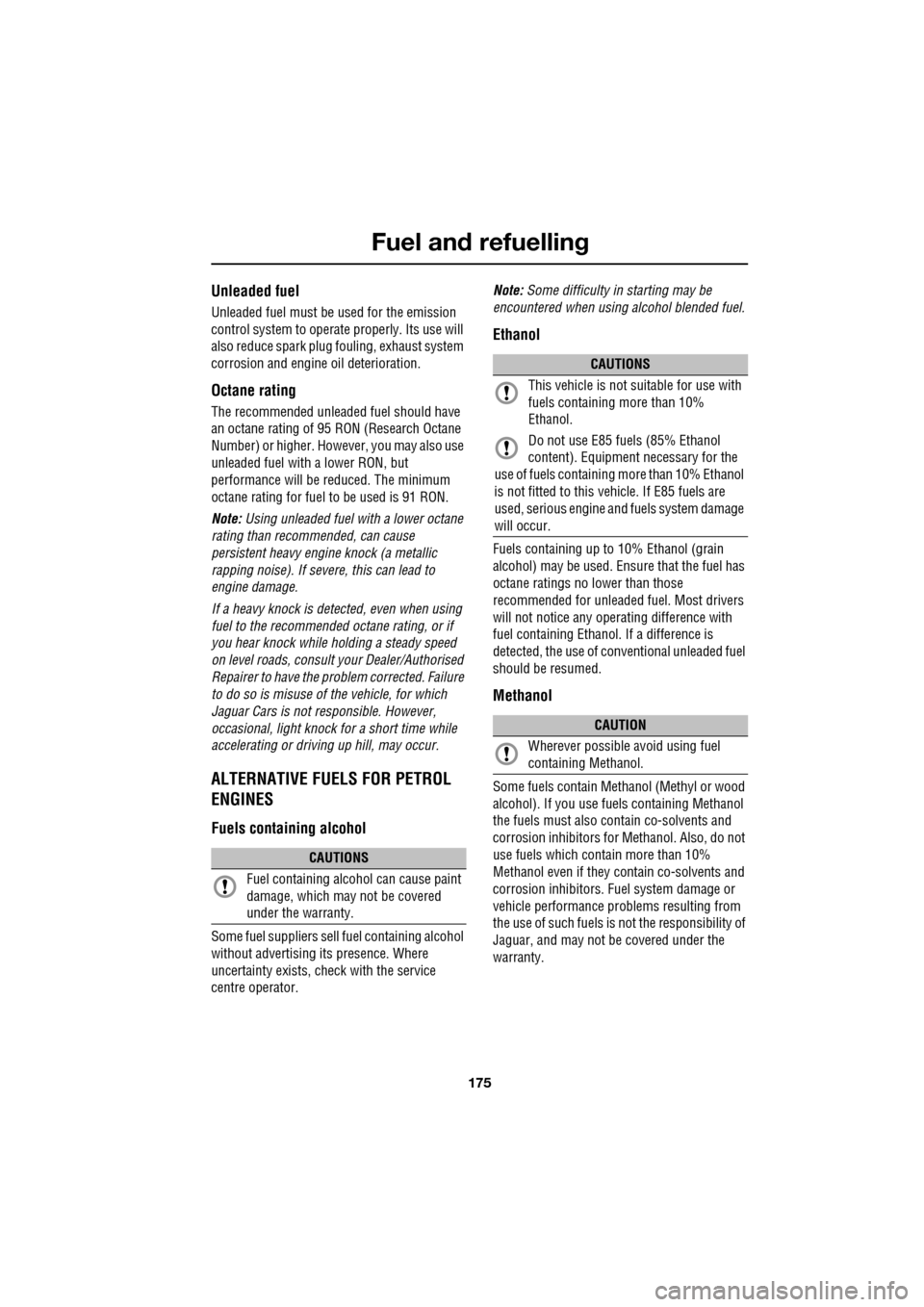
175
Fuel and refuelling
Unleaded fuel
Unleaded fuel must be used for the emission
control system to operate properly. Its use will
also reduce spark plug f ouling, exhaust system
corrosion and engine oil deterioration.
Octane rating
The recommended unleade d fuel should have
an octane rating of 95 RON (Research Octane
Number) or higher. Howe ver, you may also use
unleaded fuel with a lower RON, but
performance will be reduced. The minimum
octane rating for fuel to be used is 91 RON.
Note: Using unleaded fuel wi th a lower octane
rating than recommended, can cause
persistent heavy engi ne knock (a metallic
rapping noise). If severe , this can lead to
engine damage.
If a heavy knock is dete cted, even when using
fuel to the recommended octane rating, or if
you hear knock while ho lding a steady speed
on level roads, consult your Dealer/Authorised
Repairer to have the problem corrected. Failure
to do so is misuse of the vehicle, for which
Jaguar Cars is not responsible. However,
occasional, light knock for a short time while
accelerating or driv ing up hill, may occur.
ALTERNATIVE FUELS FOR PETROL
ENGINES
Fuels containing alcohol
Some fuel suppliers sell fuel containing alcohol
without advertising its presence. Where
uncertainty exists, check with the service
centre operator. Note:
Some difficulty in starting may be
encountered when using alcohol blended fuel.
Ethanol
Fuels containing up to 10% Ethanol (grain
alcohol) may be used. Ensure that the fuel has
octane ratings no lower than those
recommended for unleaded fuel. Most drivers
will not notice any opera ting difference with
fuel containing Ethanol. If a difference is
detected, the use of c onventional unleaded fuel
should be resumed.
Methanol
Some fuels contain Meth anol (Methyl or wood
alcohol). If you use fuels containing Methanol
the fuels must also contain co-solvents and
corrosion inhibitors fo r Methanol. Also, do not
use fuels which contain more than 10%
Methanol even if they contain co-solvents and
corrosion inhibitors. Fuel system damage or
vehicle performance pr oblems resulting from
the use of such fuels is not the responsibility of
Jaguar, and may not be covered under the
warranty.
CAUTIONS
Fuel containing alc ohol can cause paint
damage, which may not be covered
under the warranty.
CAUTIONS
This vehicle is not suitable for use with
fuels containing more than 10%
Ethanol.
Do not use E85 fuels (85% Ethanol
content). Equipment necessary for the
use of fuels containing more than 10% Ethanol
is not fitted to this vehicle. If E85 fuels are
used, serious engine a nd fuels system damage
will occur.
CAUTION
Wherever possible avoid using fuel
containing Methanol.
Page 176 of 391

Fuel and refuelling
176
Methyl Tertiary Butyl Ether (MTBE)
Unleaded fuel containing an oxygenate known
as MTBE can be used provided that the ratio of
MTBE to conventional fuel does not exceed
15%. MTBE is an Ether based compound
derived from Petroleum, which has been
specified by several refiners as the substance
to enhance the Octane rating of fuel.
Reformulated gasoline
Several petroleum comp anies have announced
the availability of reformulated fuels. These
fuels are specially formulated to further reduce
vehicle emissions. Jagua r fully supports all
efforts to protect and maintain ambient air
quality and encourages the use of reformulated
gasoline, where available.
DIESEL ENGINED VEHICLES
Use only high quality diesel fuel according to
EN590 or equivalent.
The quality of diesel fu el is variable, depending
on geographic location . Always use premium
or the highest quality fuel available in your
locality. High quality fuel ensures a longer life
for your engine components. Lower grade fuel
contains higher levels of sulphur, which is
detrimental to engine components. If low
quality fuel is used, light coloured smoke may
be evident at the exhaust.
Note: Jaguar vehicles ar e capable of running
with up to a 5% blend of bio-diesel, in
accordance with European Standard EN590. Prolonged use of additives is not
recommended. Do not add paraffin or petrol to
diesel fuels.
Winter grade diesel fuel
To make sure of relia
ble diesel engine
operation during cold seasonal periods, Winter
grade fuel must be used . This fuel is normally
available from fuel retailers during these
periods and the fuel companies adjust the fuel
quality to suit climatic conditions.
If the vehicle is not filled with Winter grade
diesel fuel, it is recommended that the engine
is idled for a period of over two minutes after
starting, to prevent fuel solidification during
operation.CAUTION
Do not use RME (bio-d iesel) except in
the case of those propr ietary diesel fuels
which contain a mix of up to 5%. Jaguar can
accept no responsibility for damage caused by
using RME in concentrat ions greater than 5%.
CAUTIONS
If you inadvertently fill your vehicle with
petrol instead of di esel, do not attempt
to start the engine. Contact your Dealer/
Authorised Repairer im mediately. Attempting
to start the engine with petrol in the fuel tank,
will cause extensive dama ge to the engine and
fuel system, which will not be covered by your
Jaguar warranty.
Jaguar cars can ac cept no responsibility
for any damage caused by running your
vehicle with petrol or ve getable oil in the fuel
tank.
Page 177 of 391

177
Fuel and refuelling
Sulphur content
In some countries diesel may contain higher
levers of Sulphur, wh ich could cause damage
to the vehicle, if in doubt contact a local
Dealer/Authorised Repairer for advice.
RUNNING OUT OF FUEL
Note: If the vehicle does run out of fuel, a
minimum of 4 litres (0.9 gallons) will be
required to restart the engine. The vehicle will
need to be driven 1.6-5 km (1-3 miles) in order
to reset the engine management and
monitoring systems.
Note: If the vehicle does run out of fuel,
seeking qualified assistance is advisable.
Diesel engines
Vehicles with diesel e ngines are equipped with
a system to prevent the fuel tank from
emptying completely. When the fuel reaches a
minimum level, the system will activate a
reduced power mode (i.e . the engine will not
run properly). This will be followed by the
engine stopping in a pproximately 1.6 km
(1 mile). This feature prevents the fuel system from
running dry, which could cause damage to the
vehicle. If the gauge indicates low fuel or the
warning indicator illumi
nates, the fuel tank
should be refuelled as soon as possible at the
next filling stat ion, with at least 4 litres (0.9
gallons) of fuel.
If the system protection function has activated,
the vehicle must firstly be refuelled, then
restarted using the following procedure:
1. With the brake pedal pressed, press and
hold the engine START/STOP button and
crank the engine for five seconds.
2. Release the START/STOP button.
3. With the brake pedal pressed, press and
release the START/STOP button to crank
the engine. The engine should start within
approximately five seconds.
Note: If the engine does not start, pause for ten
seconds with the ignition in convenience
mode, before re peating the procedure from the
beginning.
FUEL CUT-OFF
The fuel system cut-off forms part of the
Supplementary Restraint System (SRS) fitted
to your vehicle. Following an impact, and
depending on the severity , the fuel pump may
be switched off.
CAUTION
Your vehicle is fitted with a Diesel
Particulate Filter (DPF), the maximum
Sulphur content must not exceed 0.005%.
Using an incorrect fuel will cause serious
damage to the DPF. See DIESEL
PARTICULATE FILTER (DPF) (page 135).
CAUTION
Avoid running out of fuel. Doing so can
cause damage to th e vehicle's engine,
fuel and emission control systems.
CAUTION
Do not crank the engine for longer than
30 seconds, or damage to the fuel pump
may occur.